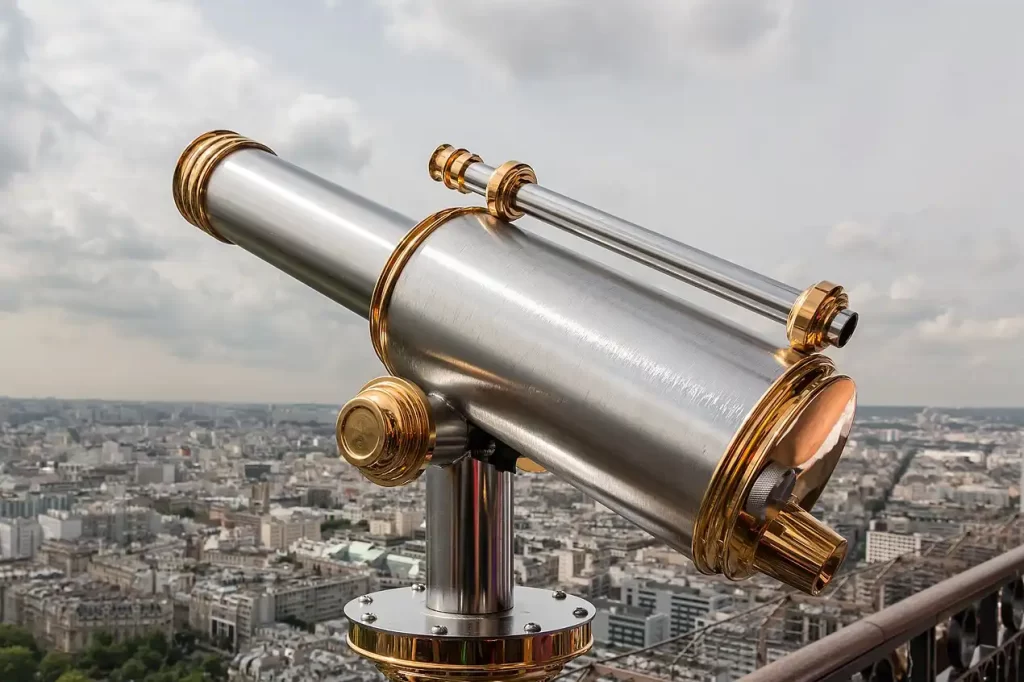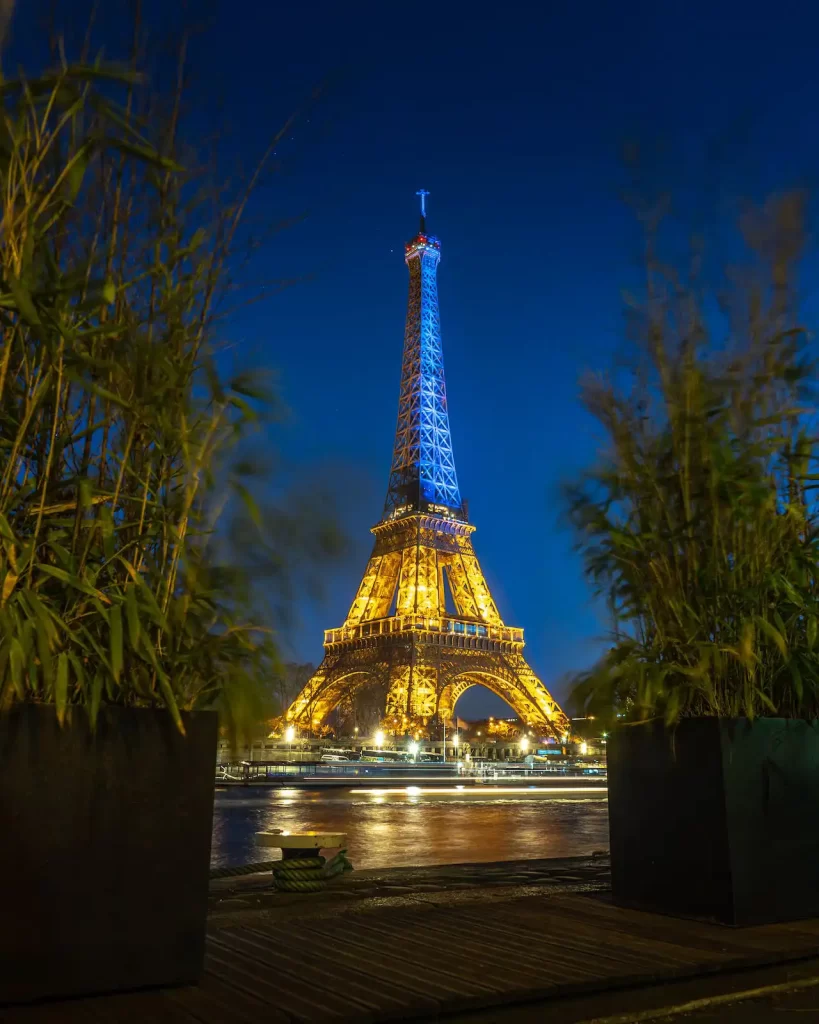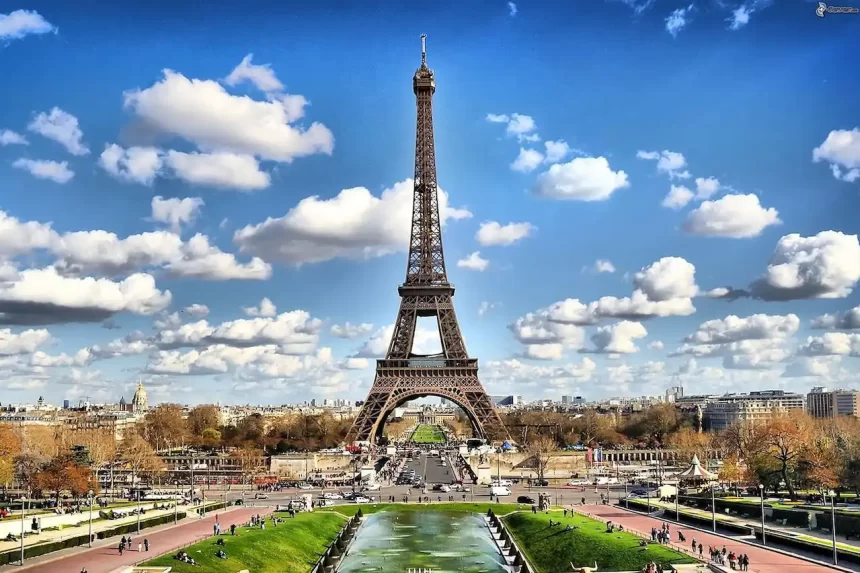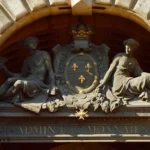The Structure Itself
The Eiffel Tower, a masterpiece of 19th-century engineering, stands as a symbol of both Paris and architectural innovation. When you first see it, you’ll be struck by its immense size and the intricate design of its iron lattice work. It’s a testament to the ingenuity of Gustave Eiffel and his team, who faced many challenges in constructing what was then the world’s tallest man-made structure.
As you approach the tower, take a moment to appreciate the details: over 18,000 iron parts held together by 2.5 million rivets, all painstakingly assembled over two years. It’s a fascinating blend of art and engineering, with its elegant curves and complex ironwork creating a sense of awe. Whether you’re seeing it for the first time or the hundredth, the Eiffel Tower never fails to impress.
And it’s not just about its external beauty. The Eiffel Tower has played a significant role in scientific research, including experiments in physics and broadcasting early radio signals. Gustave Eiffel himself had a keen interest in aerodynamics and even used the tower for several experiments. So, as you admire this iconic structure, remember that you’re standing in front of a monument that’s not just beautiful but has also contributed greatly to science and technology.
Observation Decks
The Eiffel Tower’s observation decks are where the magic of Paris comes to life. The second level, situated at 115 meters, offers a stunning vista of the city’s landmarks like the Seine River, the Louvre, and Notre Dame. But it’s from the top level, at a dizzying height of 276 meters, that you can truly appreciate the grandeur of the City of Lights. On a clear day, the view extends up to 70 kilometers, offering a breathtaking panorama of Paris.

As you ascend to these decks, either by lift or for the more adventurous, by stairs, the changing perspectives of Paris are a photographer’s dream. The hustle and bustle of the city below slowly transforms into a serene, almost miniature world. The observation decks are equipped with telescopes and informative panels, helping you identify various Parisian landmarks and learn about their history.
And let’s not forget the romance! The Eiffel Tower, especially its top deck, is a place where many come to celebrate love. Whether it’s marriage proposals, anniversary celebrations, or simply enjoying the twinkling city lights with a loved one, the observation decks of the Eiffel Tower offer an unforgettable romantic backdrop. So, be sure to capture these memories with photos, or just soak in the moment, surrounded by one of the most spectacular urban panoramas in the world.
Gustave Eiffel’s Office
At the summit of the Eiffel Tower lies a hidden gem that history enthusiasts will adore – a reconstruction of Gustave Eiffel’s office. This charming little space has been restored to its original condition, complete with period furniture and wax figures of Eiffel, his daughter Claire, and the famous inventor Thomas Edison. It’s like stepping back in time to the tower’s early days.
In this office, visitors get a glimpse into the world of Gustave Eiffel. It’s intriguing to imagine him working here, overseeing the construction of his masterpiece and entertaining notable guests like Edison. The presence of Edison’s wax figure is particularly significant, as he gifted Eiffel one of his phonographs, a momentous occasion that’s commemorated here.
Don’t miss out on this intimate look into the life of one of history’s greatest engineers. The office, although small, offers a unique perspective on the personal and professional life of Gustave Eiffel. It’s a quiet, reflective space that contrasts with the bustling activity of the observation decks, providing a more personal connection to the tower’s history.
The Glass Floor
Step onto the first level of the Eiffel Tower and experience the thrill of walking on air! The glass floor, installed during the tower’s recent renovation, offers a dizzying view 57 meters straight down to the ground. It’s both exhilarating and slightly nerve-wracking, but completely safe and an absolute must-try for visitors.
This transparent floor provides a unique perspective of the tower’s structure – you can see the intricate iron lattice work beneath your feet. It’s a fantastic opportunity for unique photos, whether you’re lying down, sitting, or just bravely standing on the glass. Kids especially love the experience, and it’s a fun way for them to learn about architecture and engineering.
Around the glass floor, there are also interactive exhibits and displays, offering insights into the history and construction of the Eiffel Tower. You can learn about the tower’s role in scientific experiments, its cultural significance, and the challenges faced during its construction. The glass floor experience is not just a visual thrill but also an educational journey.
Dining Options
Dining at the Eiffel Tower is an experience in itself, blending exquisite French cuisine with unparalleled views of Paris. ‘Le 58 Tour Eiffel’ on the first level offers a chic brasserie-style setting, perfect for a casual yet sophisticated dining experience. The menu features classic French dishes with a modern twist, and the panoramic windows provide a beautiful backdrop.
For a more upscale experience, ‘Le Jules Verne’ on the second level is a Michelin-starred restaurant that offers a culinary journey like no other. Helmed by renowned chefs, the restaurant serves gourmet French cuisine in an elegant setting. Dining here is not just about the food but the whole experience – the view, the ambiance, and the impeccable service.
Whether you choose the casual elegance of ‘Le 58 Tour Eiffel’ or the refined luxury of ‘Le Jules Verne,’ it’s advisable to make reservations in advance. Dining at the Eiffel Tower is popular among both tourists and locals, and it’s an experience you won’t want to miss. Imagine sipping a glass of fine French wine as you gaze out over the city lights – it’s the perfect way to cap off your visit to this iconic landmark.
Champ de Mars
The Champ de Mars, a vast green space stretching beneath the Eiffel Tower, offers a different but equally enchanting experience. This public garden is a popular spot for both Parisians and tourists, ideal for picnics, leisurely strolls, or just lounging on the grass. With the Eiffel Tower as a backdrop, it’s also a prime spot for photography, especially during sunrise or sunset when the light is just perfect.

Throughout the year, the Champ de Mars is a venue for various events and celebrations, from open-air concerts to national celebrations like Bastille Day, complete with a spectacular fireworks display. It’s also a great place for families, with playgrounds for children and plenty of open space for everyone to enjoy.
As evening falls, the Champ de Mars becomes one of the best places to witness the Eiffel Tower’s light show. When the tower lights up and sparkles, the view from the Champ de Mars is simply magical. It’s a moment that captures the romance and beauty of Paris, making it a cherished memory for any visitor.
The Light Show
Every evening, the Eiffel Tower transforms into a glittering spectacle that is a delight to behold. The golden lights that adorn the structure give it a warm, inviting glow, and on the hour, every hour, the tower sparkles with thousands of twinkling lights for five magical minutes. This light show is a must-see for any visitor to Paris, as it encapsulates the charm and romance of the city.

The best places to view this enchanting display are from the Champ de Mars or across the Seine on the Trocadéro Gardens. As the lights dance and shimmer, it’s a perfect time for photography or simply to enjoy the moment. The light show, especially when viewed against the backdrop of the night sky, creates an almost fairy-tale like atmosphere.
This nightly spectacle also serves as a reminder of the Eiffel Tower’s enduring appeal and its status as a symbol of Paris. Whether you’re seeing it up close or from a distance, the light show is an unforgettable Parisian experience, combining art, technology, and history in a dazzling display.
Climbing the Stairs
For those looking for a bit of adventure and a unique perspective of the Eiffel Tower, climbing the stairs to the second level is a must-do. The journey involves 704 steps, leading you through the very structure of the tower. As you ascend, you’ll see the intricate ironwork up close, and the changing views of Paris provide a rewarding experience.
Climbing the stairs is also a chance to beat the queues for the elevators and engage in a bit of exercise. Along the way, there are several platforms where you can stop, catch your breath, and enjoy the views. It’s a gradual ascent, allowing you to appreciate the tower’s engineering and the city’s landscape at a leisurely pace.
Reaching the second level by stairs gives a sense of accomplishment and offers a different perspective than taking the elevator. You’ll be able to see parts of the structure that are not visible otherwise, making it a unique experience even for those who have visited the tower before. Just remember to wear comfortable shoes and bring some water!
The Eiffel Tower Museum
Located on the first level, the Eiffel Tower Museum offers an insightful journey into the history and significance of this world-renowned structure. The museum features an array of exhibits, including historical photographs, architectural drawings, and documents that tell the story of the tower’s conception, construction, and its role in Parisian and global culture.
Interactive displays and models provide a deeper understanding of the engineering challenges overcome during its construction. You’ll learn about the public’s initial skepticism, the artistic and scientific purposes the tower has served over the years, and how it became an enduring symbol of France.
The museum experience is both educational and entertaining, making it a worthwhile visit for all ages. It’s fascinating to see how the Eiffel Tower, initially intended as a temporary structure for the 1889 World’s Fair, has evolved into a permanent and beloved icon. The museum also offers insights into the many cultural references to the Eiffel Tower in art, literature, and film, showcasing its impact on popular culture.
Visitors can also explore the various technological advancements and renovations the tower has undergone. This includes the installation of the glass floor, the development of its lighting system, and the ongoing maintenance efforts that keep it standing proudly. It’s a tribute to the tower’s continuous evolution and its adaptability to modern times.
The Eiffel Tower Museum is more than just a collection of artifacts; it’s a narrative of ambition, vision, and enduring charm. It adds depth to your visit, enriching your understanding of this global landmark. Whether you’re a history buff, an engineering enthusiast, or just curious about this famous structure, the museum offers a captivating look into one of the world’s most recognizable monuments.
Special Events
The Eiffel Tower is not just a static monument; it’s a vibrant venue that hosts a variety of special events throughout the year. From art exhibitions to cultural celebrations, the tower provides a unique setting for events that are as memorable as the landmark itself.
One of the most spectacular events is the Bastille Day celebration on July 14th. This national holiday is marked by an awe-inspiring fireworks display that lights up the Parisian sky, with the Eiffel Tower at its center. The sight of fireworks bursting around the tower is truly a once-in-a-lifetime experience, drawing thousands of spectators from around the world.
In addition to national celebrations, the Eiffel Tower also hosts seasonal events, like summer concerts in the Champ de Mars, and special exhibitions within the tower itself. These events often feature collaborations with artists and cultural institutions, adding a contemporary twist to the historic landmark. Whether you’re visiting during a major holiday or a regular day, it’s always worth checking out the tower’s event schedule for something extra and unexpected.
The Eiffel Tower is more than just an architectural wonder; it’s a living part of Paris that continues to inspire and delight visitors from all corners of the globe. Each aspect of the tower, from its observation decks to its special events, offers a unique experience that encapsulates the charm and beauty of Paris. So, when you visit, take your time to explore, savor, and immerse yourself in the magic of the Eiffel Tower.
Fascinating Details About the Eiffel Tower
- When it was built, the Eiffel Tower became the world’s tallest man-made structure, exceeding the height of the Washington Monument by more than 100 meters. It retained this title until 1930, when the Chrysler Building in New York City surpassed it.
- The Eiffel Tower consists of over 18,000 metal components and 7,300 tons of iron, all held together by 2.5 million rivets.
- Initially, not everyone was a fan of the Eiffel Tower. A group named The Committee of Three Hundred, which included French artists, writers, and intellectuals, actively opposed its construction. Critics at the time labeled it “monstrous,” “vulgar,” and “useless,” comparing it to a “metal asparagus” and a “black smokestack.”
- Gustave Eiffel, the tower’s creator, even had a private office at its summit. Today, visitors can see this restored office on the tower’s top floor.
- As the world’s most visited paid monument, the Eiffel Tower attracts around 7 million visitors annually and has welcomed over 300 million people since its opening in 1889.
- Every seven years, the tower undergoes repainting by hand, consuming around 60 tonnes of paint to protect it from rust and pollution. Its original reddish-brown color has changed over time, with the “Eiffel Tower Brown” shade in use since 1968.
- The Eiffel Tower’s design has inspired numerous structures worldwide, including over a dozen near-exact replicas in countries like China, Mexico, Russia, and the United States. Its influence is also seen in various other buildings, such as the Tokyo Tower.
- Around 20,000 light bulbs are needed to light up the Eiffel Tower. Initially illuminated by gas lamps, it switched to electric lighting in 1958.
- In 2007, an American woman named Erika Labrie, deeply enamored with the Parisian landmark since her 2004 visit, held a commitment ceremony to “marry” the Eiffel Tower, even adopting the name Erika Eiffel.
- The Eiffel Tower’s height continues to increase over time. Originally standing at 312 meters, it has grown due to the addition of various communications antennas. The most recent height adjustment was in March 2022, when a new digital radio antenna was installed, increasing its height to 330 meters (1,083 feet), 6 meters (20 feet) more than its previous 324 meters (1,063 feet).











